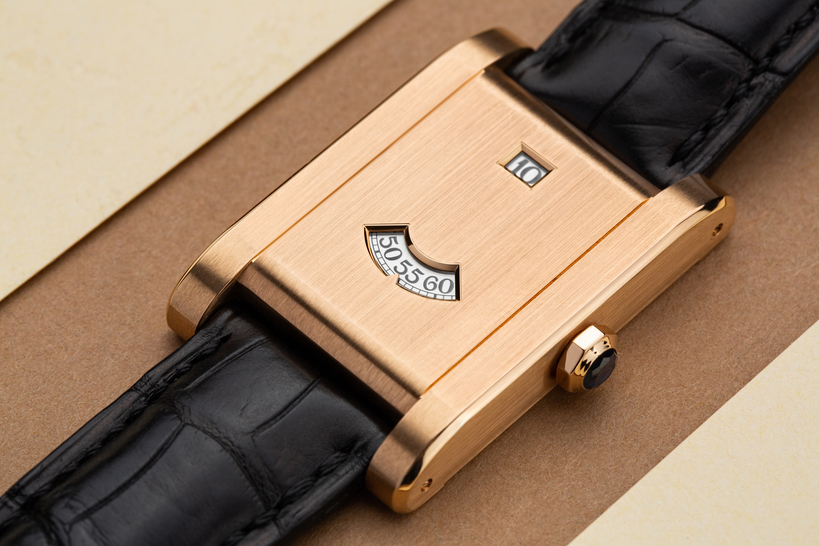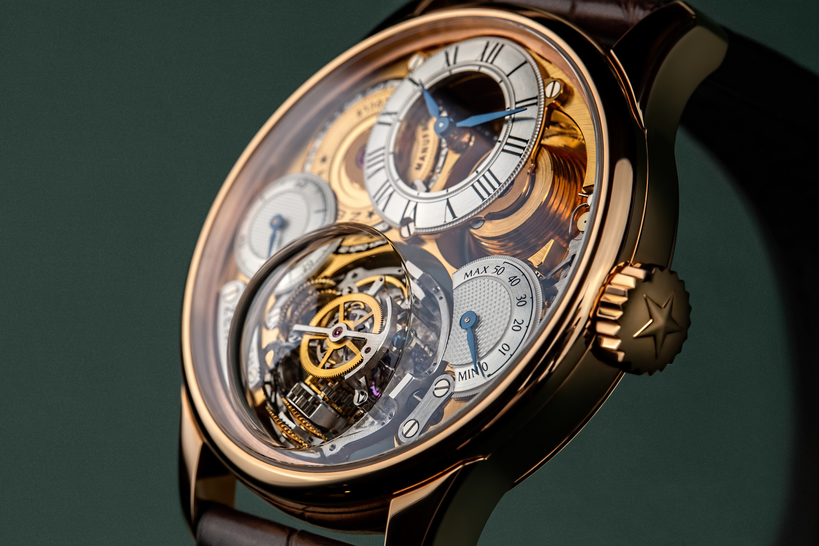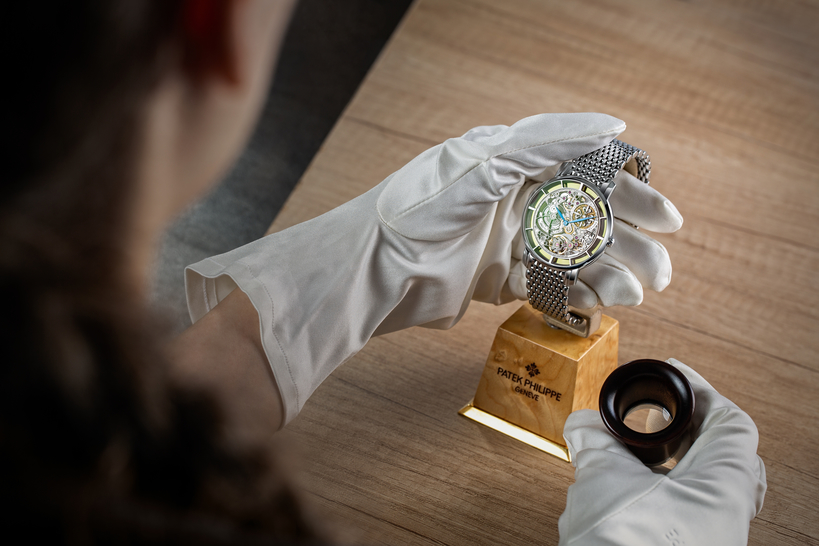We discuss the rare models that went under the hammer at the New York auctions in December 2024.
The traditional New York sales held by the big three auction houses in December went fairly well, albeit not very well. The mood there fit perfectly into the broader picture of the pre-owned watch market in 2024.
Phillips On Top As Always
Phillips New York Watch Auction: XI was spaced out over three sessions (Session I, TimeForArt, and Session II) held on December 7–8, where 180 lots raised a decent sum of USD 30,295,744. The favorite came out on top: a minute repeater by the independent watchmaker Philippe Dufour.
The unique Philippe Dufour Grande and Petite Sonnerie is an extremely complicated watch, housed in a 41-mm white-gold case. Dufour created it in 2016. In a nutshell, this was the world's first Grande and Petite Sonnerie striking wristwatch.
The watchmaker equipped the movement with two gear trains and two escapements. And he didn't do this because more complicated watches are cooler and more expensive, but to make the watch far more reliable in comparison to regular minute repeaters.
On top of that, Dufour set himself the most demanding goal by envisaging his repeater as a skeleton, which necessitated the most exquisite quality finishing on each of the movement's components.
That explains why the watchmaker came up with the idea in 1989, but the first piece in yellow gold was only presented in 1992, and Dufour has only been able to make eight of these pieces so far. Every one of them is highly anticipated at the auctions.
By the way, the very first yellow-gold example sold for CHF 5,127,000 (about USD 5,701,224) last year. The present example in white gold and engraved no. 7 was bought for USD 3,690,000. The second most expensive lot at Phillips New York auction was another minute repeater made by another famous independent watchmaker, François-Paul Journe.
The F.P. Journe Grande Sonnerie Repetitions Minutes in a steel case measuring 42 mm in diameter was completed in 2019, although Journe has been honing the model since 1999, drawing inspiration from Philippe Dufour's own minute repeater.
In other words, it took the maestro 20 years of experimentation, invention (a process resulting in ten patents) and testing to finally present this minute repeater to the public. Owners of Dufour's minute repeaters have noted their incredible efficiency, comfortable wear, and simplicity of adjusting the watches. Journe's offering is no less impressive.
His signature Octa case alone was considered an ergonomic emblem. Journe managed to keep the best case specs thanks to the watch's ultra-thin manually wound Calibre 1505 movement.
While Dufour's minute repeater is activated on demand using a pusher integrated into the winding crown, Journe's has two pushers on the side like a chronograph. The one at 2 o'clock activates the minute repeater, while the one at 4 o'clock selects the mode: G (Grande Sonnerie), P (Petite Sonnerie), and S (silence).
Steel was chosen as the case material because this metal has the best properties for wristwatch repeaters. The watch sold for USD 1,754,000.
Third place at the auction was taken by Patek Philippe's Ref. 1518 from 1948. It had been extremely well-preserved. The watch's defining feature is its rare pink-gold case and so-called Italian calendar, i.e., its very meticulous dial layout with a tachymeter scale calibrated in kilometers instead of miles.
Only eight pink-gold Italian calendar models are known to exist. The lot achieved what you could call a very decent result of USD 1,633,000. The watch that came fourth was Patek Philippe's Ref. 5531R-015, which combines two very sought-after complications among the watchmaker's fans: a minute repeater and world-time indication.
This model arrived two years ago in a 42-mm pink-gold case with a dial bearing a map of Geneva, rendered using the cloisonné enameling technique. The miniature map was created by the renowned modern enamelist Anita Porchet, whose work is in high demand. The watch went on sale In Switzerland for exactly CHF 600,000, excluding taxes.
Needless to say, collectors and investors were very interested to see how much this model would go for the first time it resurfaced at an auction. It was an impressive sum: USD 1,391,000. Another example of a lucrative investment at this auction was Patek Philippe's famous steel Ref. 3670A-001 chronograph.
Collectors are keeping a very close eye on the fate of this model, launched twelve years ago based on a 1950s movement found by chance in 1999 when the Genevan workshop relocated from rue du Rhône to Plan-les-Ouates. The manually wound Caliber 13-130 served Patek Philippe for decades.
It was used as the base movement for Ref. 130 and Ref. 1463 chronographs, many of which became iconic. After some contemplation on what to do with these finds, Philippe and Thierry Stern decided to launch a series of chronographs in vintage 37-mm steel cushion-shaped cases, limited by the obvious factor of the number of movements they'd found.
The 16-piece series appeared in 2012, and instantly sold out for CHF 240,000 a pop. This chronograph has now gone for USD 825,500. And finally, it'd be rude not to mention another model by Patek Philippe: the Nautilus Ref. 5711/1P-010, which is becoming more iconic by the year.
Not every modern model in a steel case can raise USD 6.5 million, or at times even 7.56 million. The present example is the platinum Ref. 5711 version. It was only made for private commissions, requested by special friends of the brand or ordered by clients of Tiffany & Co. like this example.
Since 2013, less than 50 examples of the Nautilus are believed to have been made in platinum. Overall, a model that sold for USD 108,200 in 2015 has grown almost eight times more expensive in nine years, raising USD 825,500. Another wonderful investment!
Sotheby's Two Sessions
Against the backdrop of Phillips, Sotheby's New York Important Watches on December 6 didn't looks so stellar: 212 lots were sold at the Important Watches auction, raising a sales total of USD 16,554,120. But as a matter of fact, Sotheby's upheld their average standard at their New York sales.
The biggest sensation at the auction was quite a hard-fought battle over an automatic chronograph in a square 40-mm steel case with a special strap and a blue dial: the Heuer Monaco Ref. 1133B from 1969.
Of course, we have to mention here that the watch had belonged to Steve McQueen, who wore it when shooting Le Mans, a landmark motorsports movie. The watch was actually made especially for this occasion. In the end, the rarity went for USD 1,440,000.
At the time this watch was made, it was one of the first automatic chronographs which really dreamed of entering the same league as the Rolex Daytona "Paul Newman". Some like the director Stanley Kubrick appreciated Heuer's offering.
This film's property master wanted the lead actor McQueen to wear one of the most popular chronographs at the time on his wrist: a Rolex, Omega Speedmaster, or Longines watch. But the Heuer Monaco chronograph that had just been launched with Europe's first automatic Chronomatic movement was a game changer.
The rectangular sharp-edged case fit the protagonist's uncompromising character, and the bright blue dial matched his eyes. Besides, this color sets off the aggressive race car livery beautifully and the branding splashed all over drivers' racing overalls. Only the film's creators decided to pair the watch with a cooler eye-catching leather strap, turning to Jack Heuer for help.
Heuer's former CEO knew how to seize an opportunity, and not only convinced the filmmakers to buy 20 chronographs from him, including six made especially for Steve McQueen, but also talked them into buying another six regular watches for the actors who played members of the team, eleven stopwatches, 17 additional timing instruments, and even two sets of Rally Master dashboard timers.
These are now considered rare artifacts. By the way, Steve McQueen's personal mechanic Haig Altounian offered one of these chronographs that the actor had given to him as a gift at an auction exactly four years ago. And it raised a better sales price than the latest result: USD 2,200,000.
Back then, no one knew that McQueen's personal chronograph would resurface at an auction so soon after in December 2024. The second most expensive watch at Sotheby's auction was a beautiful version of Patek Philippe's Nautilus Ref. 5723/112R-001 in a pink-gold case, sporting a bezel encrusted with baguette-cut rubies.
This Nautilus also happens to have been made six years ago for Tiffany & Co. It achieved a good sales price of USD 900,000, a hundred thousand above its upper estimate. Patek Philippe's Ref. 5208P made in 2020 — a minute repeating perpetual calendar monopusher chronograph gaining a cult following — may have made it into the top three, but it disappointed investors with a result of USD 780,000.
That's a few hundred thousand dollars down on its retail price. Another surprise at Sotheby's latest New York sales was the apathy towards Rolex. And this is in a market where people literally pray for watches by the biggest Swiss watch brand.
The auction house only managed to track down a full yellow-gold Rolex Daytona Ref. 6238 from 1968, which is rare in and of itself, billed as the Transitional Daytona "John Player Special". However, these collector's tip-offs were ignored by the American pre-owned watch market, where only the real-deal Daytona is in demand.
A Paul Newman is a Paul Newman, and a John Player Special is a John Player Special. That's why this model, given a fairly confident estimate of USD 500,000 - 1,500,000, only went for USD 768,000 to secure fourth place. Patek Philippe's yellow-gold Ref. 1518 perpetual calendar from 1945 had an equally lackluster reception at the American sales, which ultimately went for USD 456,000.
Sure, it may not be the rarest, but still. The general apathy among American collectors at the end of 2024 was also made apparent by the fact that two of François-Paul Journe's models sold for in and around their lower estimates.
One of them was the F. P. Journe Tourbillon Souverain Vertical from 2021 (USD 336,000), and the other, imminently set to become iconic, was F. P. Journe's Chronomètre à Résonance "Black Label" (USD 300,000). But the latest in a string of achievements by the Parisian Maison Cartier definitely deserves a mention. This time, an iconic mystery table clock from 1921 sold for USD 408,000.
It's a majestically beautiful, historic model with a rock-crystal case measuring 140 mm in height on a base measuring 85 mm in width and a bezel measuring 83 mm in width. The clock has platinum Roman numerals, yellow gold on the base and bezel, enamel decoration, and it's turquoise-set.
Another yellow-gold model sold very well: the Cartier Crash "Paris" from 1991 raised USD 216,000. The astonishing story of how this watch was born deserves to be told in more detail. The designer Rupert Emmerson and Jean-Jacques Cartier who managed the London branch are said to have created it from a Cartier Baignoire watch.
That piece had been disfigured beyond recognition when its owner ended up in a serious car crash they miraculously survived. It makes you reflect on why the most simple watches without any complications or elaborate decoration are valued today.
Treasures from Tom Brady
By the way, Sotheby's managed to squeeze in another New York sale in December with a direct connection to watches. This chapter in the GOAT (Greatest Of All Time) series of celebrity auctions has been dedicated to the greatest NFL quarterback, Tom Brady. Among other things, he's known across the pond as a serious watch collector.
So The GOAT Collection: Watches & Treasures from Tom Brady featured a Rolex Daytona "Paul Newman John Player Special" Ref. 6241 from 1969, which sold for a fairly decent sum of USD 1,140,000. But it could have realized a higher sales price. After all, Ref. 6241 is one of the rarest references.
It's estimated that only around 300 of these watches were made in yellow gold between 1966 and 1969, and few have been preserved in a more or less resalable condition to this day. Chronographs with cases and bracelets made of 14K yellow gold are especially valuable, as they were primarily made for the American market, where hallmark 585 gold is more affordable.
A unique tourbillon came second at this sale: Audemars Piguet's Royal Oak "The Roast" Ref. 26730BC.ZZ.1320BC.99 achieved a decent result of USD 720,000. It was privately commissioned by Bradley this year. The star wanted a smaller white-gold case measuring 41 mm in diameter with a bezel encrusted in diamonds.
With an invoice dated on April 29, Bradley didn't wear this exclusive tourbillon for long. The watch owner clearly wasn't happy about something. Three watches by Richard Mille realized surprisingly modest sums. After all, Americans adore Richard Mille's creations, and these ones were even worn on the greatest quarterback's wrist.
Despite all of this, the Reference RM35-03 FQ "Baby Nadal" model in a white-and-blue case made of Quartz TPT in 2022 sold for USD 384,000. The titanium Richard Mille RM65-01 split-seconds chronograph from 2022 went for USD 288,000, and the Richard Mille RM11-03 CA flyback chronograph in a Carbon TPT case made in 2020 went for USD 336,000.
This backdrop makes it all the more intriguing that Patek Philippe's "First Series" Ref. 3970 perpetual calendar chronograph from 1986 in a yellow-gold case consigned by none other than Tom Brady only realized USD 312,000. And it was the second example ever produced! Now that's one very lucky buyer!
The new owner of the TBXII Grand Complication pocket watch retailed by Tiffany & Co. is even luckier. The unique minute repeating perpetual calendar with a split-seconds chronograph in a 53.5 mm case was snapped up for USD 264,000.
By the looks of it, a lot of collectors didn't know this sale was being held, and the major auction house must have also been distracted from the event. But then again, maybe the bidders spent much of their enthusiasm on Tom Brady's jerseys, and there were quite a few of those too, which went for right up to USD 720,000.
Cautious Christie's
Christie's auction house paled in comparison to competitors: 103 lots were sold, realizing a sales total of USD 10,892,992. The favorites at the Important Watches sale were Richard Mille, Patek Philippe, and Cartier. First place was expected to be taken by the unique white-gold Richard Mille Unique RM018 "Hommage à Boucheron" tourbillon, launched to celebrate the legendary luxury jewelry and watch house's 150th anniversary in 2008.
What makes this reference historically important is that it was the first to be fitted with a movement made with sapphire crystal plates, which gave birth to the fully transparent RM56 and RM56-1 models. And on top of that, Richard Mille sought to diversify the limited edition of 30 pieces in the anniversary "Hommage à Boucheron" series to the max.
Through the ribs of the skeletons, different examples show off what they are set with: diamonds, onyx and tiger's eye... So every piece in the series has been made unique. In the end, the tourbillon which was estimated to go for USD 800,000 - 1,500,000 finished with a decent result of USD 1,197,000.
But that was only the second most expensive lot! It was unexpectedly overtaken by Richard Mille's RM UP-01 Ferrari Ultra-Flat in first place: the 37th piece in the series of 150. This novelty arrived in 2024. The watch's titanium case measures a mere 1.75 mm in height, and the movement it houses is a wafer-thin 1.18 mm thick.
It was the world's thinnest mechanical watch right up until September 2024, when the Russian watchmaker Konstantin Chaykin launched his ThinKing model that measures 1.65 mm in height. Mille spent several years working on his thin watch. His new escapement allowed him to dramatically slim down the movement.
It was created based on a traditional anchor escapement, only serious visible changes have been made, eliminating the guard pin and the safety roller, and this dart-free anchor allowed the watchmaker to significantly reduce the height of the mechanism. The stable performance of the balance increases the mainspring barrel's rate of winding to one full revolution every six hours.
All of this is definitely good news, but these watches rarely attract attention from collectors. There's a logical reason behind this. For example, the thinner the minute repeater, the less resonance there is in the chamber, i.e., the quieter it sounds. The thinner the watch, the less reliable it is, no matter what its creators may say.
Some people see these watches as pure fun or cool gimmicks, while other more serious folks appreciate their major contribution to the development of watchmaking and art. But to put it lightly, none of this really appeals to collectors and investors. The prestige of owning a record-breaking watch is also questionable.
At the end of the day, Mille held the leanness record from April to September when Chaykin took it. Piaget and Bulgari are bound to have responses in the pipeline that we won't need to wait long for — half a year, max. By the way, the final sales price here would back this up. The watch that retailed for around USD 1,880,000 was given an estimate of USD 1,000,000 – USD 2,000,000, and it sold for USD 1,381,000.
We think that this particular watch might have been consigned by Richard Mille himself as a tried-and-tested method to determine how much investors are willing to shell out for his record-breaking watches, because the waiting list for this model is already backed up for years to come. So it's fairly plausible, right? This would be the perfect time to congratulate Cartier yet again on securing third place at Christie's New York sale.
Another Cartier London Crash from 1986 surpassed its estimate here and sold for USD 819,000. This one was in a yellow-gold case measuring 42.5 mm in... Let's call it length. The piece is one of only three known examples of the 1986 Crash. Now that's a record, real rarity, and genuine timelessness! And there was another one: a second Cartier Crash made in 2010 sold here for an impressive USD 252,000.
Credits provided by: www.phillips.com, www.sothebys.com, www.christies.com






































